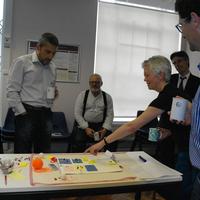Those who study the health and wellbeing of older adults emphasize the importance of having opportunities to remain active, civically engaged, and socially connected with others – across generations and across community settings.
To this end, we focus on the challenge of creating community spaces that engender an important dimension of social connectedness, i.e., intergenerational engagement. We posit that such meeting places – or Intergenerational Contact Zones; if designed in ways that are consistent with people’s interests and needs for strengthening their connections with family, friends, and neighbours; can have a profound impact not only on the quality of life of older adults, but for all community residents.
Intergenerational Contact Zones – or ICZs for short, serve as spatial focal points for older adults and younger generations to meet, interact, build trust and friendships, and work together to address issues of local concern. They can be found in all types of community settings including libraries, schools, parks, and multi-service community centres.
The topic of ICZs took centre stage at a meeting held at the Oxford Institute of Population Ageing this summer (26 June 2015). A multi-disciplinary group of 13 scholars and practitioners engaged in groundwork discussions and collaborative inquiry aimed at exploring existing approaches and charting new strategies for creating and/or enhancing intergenerational spaces.

During a “think tank” on Intergenerational Contact Zones hosted by the Oxford Institute of Population Ageing, workshop participants engaged in an exercise aimed at exploring ways to apply intergenerational design concepts in various community settings. Pictured (from left to right): Mariano Sanchez (Associate Professor of Sociology at the University of Granada, Spain; AESE Visiting Scholar - 2012-13 and Penn State Center for Healthy Aging international affiliate faculty), Alan Hatton-Yeo (MBE, Director of Age Friendly Communities Wales and Communities for All Ages/UK), Susan Langford (MBE, Director, Magic Me – London), Matt Kaplan (Professor, Penn State University; Visiting Fellow, Oxford Institute of Population Ageing), and Jaco Hoffman (James Martin Senior Research Fellow, Oxford Institute of Population Ageing; Professor, Ageing and Generational Dynamics in Africa Programme, North-West University, South Africa).
The workshop was highly participatory, involving a series of mini presentations and team problem-solving exercises designed to challenge participants to explore ICZ-related concepts and design possibilities in a range of community settings.
As we learned from the rich insights and resources shared by participants, during and after the meeting, ICZs can serve several functions, including:
- conceptual tool – for studying complex, multi-generational community settings
- design tool – for generating innovative ideas for developing intergenerational meeting spaces
- programming tool – for broadening the range of intergenerational activity possibilities.
Leng Leng Thang, Japan Studies professor at the National University of Singapore who participated via Skype, noted how the ICZ concept provides a useful framework for studying the intergenerational engagement capacity of public places. She shared results from her research at two sites: one was a playground in Singapore which is co-located with exercise stations for older persons and a “community café” in Japan (Fukuoka) which draws older people meeting for tea as well as young children and their mothers. Although much of the space within both sites is used to accommodate mono-generational activity, the ICZs within these sites (i.e., the spatial intersections between these activity areas) provide fertile opportunities for increasing intergenerational contact and expanding community residents’ social networks and support systems.
Workshop participants explored ICZ-focused design possibilities for schools, libraries, parks, and other community settings.
The focal point for a school-based design scenario was an empty classroom in an elementary school in a neighbourhood with a declining student base. Participants proposed transforming the classroom into a holding and training area for older adult volunteers who have varied skills and interests to help the school and its students. The design also functioned to convert this space into a vibrant hub of intergenerational activity focused on contributions that volunteers can make to students’ academic and socio-emotional growth.
In response to the challenge of redesigning an underutilized community room in a local library, participants created a high tech space with several intergenerational connection nodes, each designed to attract and engage multi-age groups in rich, collaborative learning experiences. One distinctive feature of this library community room design is its flexibility. Besides the storage area, the only fixed space was a green screen, where oral histories and life reviews could be recorded either by oneself or together with partners, adding to a collection of visitors’ personal and community narratives that grow in an organic way.
Tablets (as opposed to desktops/laptops) were stacked on the table in accordance with the flexibility theme. Workspaces could be created anywhere in the room and be moved around depending on need.
The library room design described above diverges significantly from traditional library settings; upon entry, instead of seeing rows of books, visitors step into a virtual environment layered on the physical environment. This type of novel design is likely to have some allure for administrators of libraries, art galleries, museums and other “natural” intergenerational spaces who recognize a need to reinvent their settings in the new interconnected and digital world.
Such an embrace of new technology to facilitate intergenerational connections led workshop participants to address the question whether ICZs exist in the virtual world. Alan Hatton-Yeo, director of Age Friendly Communities Wales and Communities for All Ages, UK, noted that it is possible to regenerate old existing community (physical) spaces by linking them to the virtual world using tools such as ‘Historypin’[1]. Such online platforms are important tools for helping community residents to record and share the meanings and memories they ascribe to local places. As such, they are important engagement tools for community residents interested in studying community history and generating plans for future community development.
Throughout the day-long workshop, participants came up with the following list of tentative “principles” for developing creative and effective ICZs:
- Choice: In the quest to create ICZs, make sure to give people “choice” and allow them to exercise this choice on their own terms. This includes allowing people to decide the extent to which they want to interact with others in public spaces. Interaction should not be forced. In a park, for example, some people may prefer their interaction to be “passive,” like sitting and watching children play.
- Visibility: Make the purpose of ICZs visible so people can know the options for intergenerational interaction presented by any intergenerational setting before even entering that setting.
- Addition: In the context of working to improve existing ICZs, continuously consider what can be added to existing spaces to encourage people to engage in group activities which could give them an intergenerational experience.
- Meaningfulness: Plan activities that help people unearth and share their personal narratives and the various meanings they ascribe to existing ICZ spaces.
- Diversity in scale: ICZs could be planned and operationalized on a range of scales – on a macro scale, such as in the context of designing a city’s waterfront area, shopping district, or transportation system; a meso scale, such as the seating area provided within a town square; and micro scale, such as the configuration of the vestibule space outside individual dwellings in an intergenerational housing project.
- Tradition and modernity can coexist: There are benefits to designing ICZs to include traditional elements (which have interpersonal binding importance) and high-tech elements (which can generate additional modes of interaction).
These preliminary principles are presented not as a rigid set of rules or guidelines, but rather as part of a broader effort to crystalize our understanding of the overall ICZ concept and lay the foundations for exploring new applications for intergenerational living and learning.
Available upon request (msk15@psu.edu)
- Agenda and minutes of the 26 June 2015 meeting on Intergenerational Contact Zones
- The “Many Dimensions of Intergenerational Contact Zones” handout that was distributed at the Oxford ICZ meeting
- List of ICZ workgroup members
Next steps:
- Additional postings on ICZ-related topics
- A working paper, entitled, What are Intergenerational Contact Zones and Why Should We Pay Attention to Them? – This publication will go into the initiatives and themes discussed in this blog in more depth
- An outreach education publication highlighting the ICZ concept and application principles and ideas. [Tentative title: “What to Keep in Mind When Developing Intergenerational Spaces/Settings.”]
[1] “Historypin.com is an online, global archive to which people can add photos, audio, video, stories, and memories by pinning them to a particular place and time on the Historypin map. The Historypin app also lets people add and explore content while walking around their local areas. Since its launch, Historypin has been a catalyst for numerous online and offline collaborations between older and younger people.” (Armstrong, 2012, p. 294). [Reference: Armstrong, N. (2012) “Historypin: Bringing Generations together around a communal history of time and place.” Journal of Intergenerational Relationships (10)3, 294-298.]
Opinions of the blogger is their own and not endorsed by the Institute
Comments Welcome: We welcome your comments on this or any of the Institute's blog posts. Please feel free to email comments to be posted on your behalf to administrator@ageing.ox.ac.uk or use the Disqus facility linked below.














